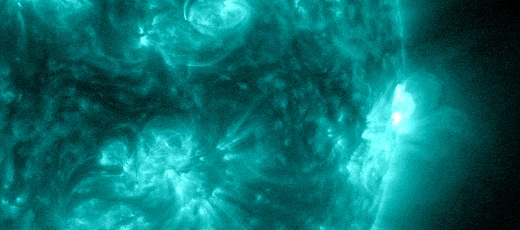[ Skywatchers ] [ Main Menu ]
48360
From: Eve, [DNS_Address]
Subject: X-CLASS SOLAR FLARE
|
X-CLASS SOLAR FLARE: Departing sunspot AR3638 exploded today (July 16th @ 1326 UT), producing an X1.9-class solar flare. NASA's Solar Dynamics Observatory recorded the extreme ultraviolet flash:  Radiation from the flare caused a deep shortwave radio blackout over the Atlantic Ocean: map. Transatlantic mariners and ham radio operators may have noticed loss of signal at all frequencies below 30 MHz for as much as an hour after the flare. Watch the movie again. It shows the explosion ascending through the magnetic canopy of the sunspot at ~45,000 mph. The upward motion probably propelled a CME into space. Stay tuned for updates as new coronagraph images become available. |
Responses:
[48365]
48365

From: ryan, [DNS_Address]
Subject: Re: X-CLASS SOLAR FLARE
|
Map: Northern lights could shine in some states amid minor geomagnetic storm by Addy Bink - 07/23/24 5:54 PM ET The aurora forecast for Tuesday, July 23, 2024. (NOAA SWPC) (NEXSTAR) — Yet another geomagnetic storm could bring the northern lights to parts of the U.S. overnight. On Monday, NOAA’s Space Weather Prediction Center (SWPC) issued a G2-level geomagnetic storm watch, saying a coronal mass ejection (CME) is expected to impact Earth on Wednesday. According to the SWPC, the halo CME erupted on Sunday. Ahead of its arrival, the SWPC warned of a minor solar radiation storm event that began Monday night. As daunting as those terms may sound, this geomagnetic activity will most likely go unnoticed by many — except, of course, those lucky enough to see the northern lights as a result. Solar storms, including CMEs, are what cause the northern lights. When the plasma and magnetic material that is hurled from the sun by CMEs collide with Earth’s magnetic field, they shoot particles toward the North and South Poles. As those particles interact with gases in the atmosphere, they create excess energy that appears as bursts of light, better known as the aurora. Northern lights: Will you get to see them again this summer? The stronger the geomagnetic storm (the term used to describe the impacts of the aforementioned solar activity), the further south the northern lights will be visible in the U.S. Like tornadoes and hurricanes, geomagnetic storms are measured using a 5-point scale. At the lowest end is G1, which is considered minor but strong enough to make the northern lights visible into the northern U.S., like Maine and Michigan’s Upper Peninsula. A G5 storm, described as extreme, could send the northern lights as far south as Florida and southern Texas. While the SWPC initially issued a G2 watch, the forecast (seen below) puts the expected geomagnetic activity at a G1 level. Unfortunately for those in the southern portion of the U.S., that means any northern lights that are bright enough to shine Tuesday night into Wednesday will only be visible to the states closest to the Canadian border. The SWPC’s aurora forecast for Tuesday shows there is a low likelihood of those in the northern portions of Washington, Idaho, Montana, North Dakota, Minnesota, and Wisconsin seeing the celestial show. Those in parts of Wyoming, South Dakota, Iowa, Michigan, New York, Vermont, New Hampshire, and Maine may also catch a glimpse of the northern lights along the northern horizon. There have already been a handful of strong geomagnetic storms (and with them, bouts of auroral activity) this year, including some that brought the northern lights to Florida and Hawaii. While these types of storms are difficult to forecast, experts say there’s a good chance we’ll experience more in the coming year. When will hot weather end? New NOAA forecast released The sun is currently going through a solar cycle, an 11-year period in which it flips its poles. As it reaches the peak of the cycle, the sun also becomes far more active. The best part? It doesn’t seem that we’ve reached the peak of Solar Cycle 25. We may not reach solar maximum for a few months yet, Mark Miesch, a researcher with NOAA’s Space Weather Prediction Center, tells Nexstar. He also notes that more strong solar storms are expected through the rest of this year, throughout 2025, and potentially even into 2026. If the current predictions are correct, and solar maximum activity continues for the coming months, at least some Americans will have the chance to see the northern lights again soon. As for whether they’ll reach Florida and Hawaii again, you’ll have to stay tuned. |
Responses:
None
[ Skywatchers ] [ Main Menu ]